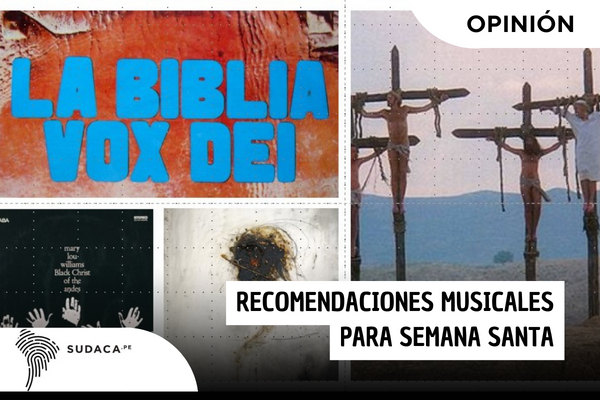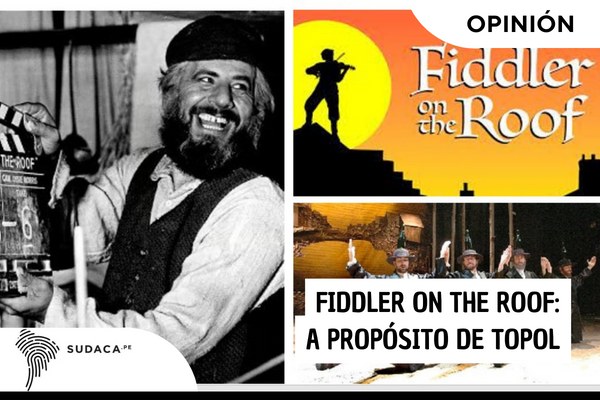[MÚSICA MAESTRO] From Johann Sebastian Bach’s oratorios, based on the New Testament, better known as “passions” -here, excerpts from the Passion according to Saint Matthew (BWV 244, 1727) – to the psychedelia of Jesus Christ Superstarpremiered in English in 1970 and in Spanish in 1975, with famous duos in the roles of Jesus and Mary Magdalene -Ian Gillan/Yvonne Elliman on the one hand, Camilo Sesto/Ángela Carrasco on the other-, the music inspired by the Week Santa – the last days of the earthly life of Jesus Christ – is notorious for its drama and emotion.
Beyond the styles used over time, each composer who undertook the task of setting biblical passages or key moments of the Catholic religion to music has done so to move, incite reflection and serve as a sound support for a story loaded with meaning. spiritual for many people around the world, regardless of whether they are believers or not. Movie soundtracks like The Ten Commandments (Cecil B. De Mille, 1956), Ben Hur (William Wyler, 1959), Jesus of Nazareth (Franco Zeffirelli, 1977) or The Passion of the Christ (Mel Gibson, 2004) -written respectively by Elmer Bernstein (USA, 1922-2004), Miklós Rózsa (Hungary, 1907-1995), Maurice Jarre (France, 1924-2009) and John Debney (USA). , 1956)-, to name just a few, are good examples of this aspect that, despite the passing of the years and the irreversible changes in the music industry, does not lose its validity, especially at this time of year. Here he gives you three other examples, in different registers, of what devotion, research and talent have generated in the last five or six decades.
MARY LOU WILLIAMS – BLACK CHRIST OF THE ANDES (SABA/Folkways Records, 1963)
The title of this record -“Cristo Negro de los Andes”- should be enough to interest us in this Georgian-born pianist/singer/songwriter. The central theme of this jazz and gospel classic is the union, through extremely pagan music such as jazz, of the Afro-American artistic heritage with its South American version, using the figure of San Martín de Porres (1579-1639) as a catalyst. our Saint of the Broom, protagonist of the first song of this extraordinary album which marked the return of Mary Lou Williams (1910-1981) after a few years of self-exile.
The song is performed 80% a cappella by The Ray Charles Singers -not to be confused with the great blind African-American musician-, a mixed choir that tells us about this “humble man who healed in the name of God”. Added to the evident religious syncretism of this spiritual song about a seventeenth-century Dominican friar born in Peru is the precise way in which Williams establishes the link between sacred music and sinful music, fusing them into one. This formula is repeated in the devil, with interesting counterpoints between the deep voices and Williams’ complex and creative solos. The same thing happens in Praise the Lorda theme that closes the album with the usual merriment and fervor in the black churches of the southern United States.
In between, an excellent selection of songs that span various genres, from avant-garde glimpses of to fungus to mungus, in which Mary Lou executes wild improvisations reminiscent of Cecil Taylor, with whom she would work a decade later; to the sophisticated and elegant interpretation of standards as It ain’t necessarily so (George Gerswin, 1935) or A great night for swinging (Bill Taylor, 1955) accompanied by notable musicians such as Percy Heath (bass), Tim Kennedy (drums), Grant Green (guitar), among others. In various compositions of her own, such as lead blues either anima christi there is a noticeable absence of metals that allows greater brilliance on the piano and gives the recordings a more intimate and soft sound environment.
The original version of the album contains only ten songs and appeared under a German label called SABA -acronym for Schwarzwälder-Apparate-Bau-Anstalt-, specializing in jazz and classical music. In 2004, the Folkways Records record label, from the prestigious Smithsonian Institute in Washington DC, released a remastered version with four additional songs: Nicole, Koolbonga, Forty-five degree angle and the spectacular chunka lunka. A visionary album, ahead of her time, by an artist who became a symbol of the integration of various elements of world black culture and her religiosity, something unusual for those years of intense racial segregation in the United States. .
VOX DEI – THE BIBLE (Disc Jockey, 1971)
In the televised version that MTV Latin America broadcast of the now classic “acoustic” concert by Soda Stereo -Comfort y música para volar (1996)-, the (un)enchufado ends with a hard, heavy song, in which Gustavo Cerati (1959- 2014) performs a virtuoso solo. Your title is Genesis and it was the first time that many people, fans of Soda Stereo but without deep knowledge of Argentine rock, found out about the existence of Vox Dei, one of the founding hard-rock and progressive rock groups of that country. Génesis opens the second album by Vox Dei, an ambitious conceptual project entitled The Bible and which, as its name indicates, contains compositions inspired by various passages from the holy book of Christianity.
It was 1971 and it is very likely that the echoes of the rock-opera Jesus Christ Superstar -published a year earlier- have inspired Juan Carlos Godoy (voice, guitar), Ricardo Soulé (voice, guitar, piano), Willy Quiroga (voice, bass) and Rubén Basoalto (drums) to conceive such a countercultural idea because, until then, Argentine rock was framed in the hippie-poetic wave of Luis Alberto Spinetta (Almendra) and the bluesy outbursts of bands like Manal or Billy Bond.
The Bible, the album, sounds aggressive, bluesy, but at the same time it has that reflective and hallucinated aura of flower power, with extensive instrumental passages and lyrics that cover the most representative stories and moments of the Testaments -creation (Genesis), the exodus of the Jewish people (Moses), David and Goliath (The wars), the predictions of the arrival of the Messiah (prophecies, wisdom books), the sacrifice of Jesus Christ (Birth, death and resurrection) and the end of time (Apocalypse)- configured an interesting listening experience with such a strong impact in its time that the Argentine ecclesiastical community even recommended schools to make their students listen to the album, at a time when rock was rather a proscribed musical expression.
Despite the importance that Vox Dei’s La Biblia had at the time, the group’s erratic career and the greater prominence of other exponents of gaucho rock gradually diminished its presence until it became, outside of Argentina of course, a well-known name. only by a tiny group of followers and did not achieve the popularity of several of his contemporaries, an oblivion that persists today despite the updating that Cerati did almost three decades ago. The lyrics, written by Soulé, do not fall into the discursive and abound in references to spirituality and introspection, addressed to the public in the form of religious songs, with an evangelizing effect. A true classic in the history of rock in Spanish that deserves to be revisited this Holy Week.
PASSION – PETER GABRIEL (Real World Records, 1989)
The cover image of this album, titled Drawing study for self image (1987), belongs to the British plastic artist Julian Grater and was not specifically commissioned to illustrate it. Yet there is something about its darkness, prickly texture, and shadowy profile – a work that uses everything from faded flowers to charcoal on canvas – that ties it to the magical combination of sounds from the Middle East, Africa and Southeast Asia that the British musician Peter Gabriel created for the soundtrack of The last temptation of Christthe controversial film that Martin Scorsese filmed in 1989, with a script based on the homonymous book by the Greek N. Kazantzakis (1883-1957), published in 1955.
Passion represents one of the high points of Peter Gabriel’s discography and imposes a very high bar for the genre known as “world music”, a letterhead that the composer inadvertently helped coin with the Festival World of Music, Arts and Dance (WOMAD), created by him in 1980. Precisely from the pool of non-European musicians who rose to the international arena thanks to Gabriel’s support and vocation, came the varied and talented staff that gave life to these organic sounds. .
It often happens that the soundtracks of movies based on biblical stories are bombastic and obvious, interpreted by monumental symphonic ensembles. Here the opposite happens. Based on what we might consider to be more realistic depictions of the deserts, cobbled streets and mountains of Judea in AD 1, Peter Gabriel and his brilliant accomplices achieve far more convincing effect than violins and trumpets. of European origin.
Passion is the eighth solo album by the former leader of Genesis and in addition to the voice -sometimes natural and others, electronically processed-, keyboards and occasional flutes by the author; It has a select multinational team of musicians, including vocalists Youssou N’Dour (Senegal), Nusrat Fateh Ali Khan (Pakistan), percussionist Hossam Ramzy (Egypt), Vatche Housepian (Armenia), a duduk player and other instruments wind player, violinist L. Shankar (India), among others. Likewise, musicians such as David Rhodes (guitars) and Manu Katché (drums), regulars in his bands, also collaborate and intersperse their appearances with other prominent session musicians such as Nathan East (bass), Billy Cobham (drums) and David Sancious (keyboards). ). Listen to topics like Zaar, A different drum, Of these hope, Troubled, It is accomplished and With this love (choir), just to mention a few, convince you that you are in front of a masterpiece of contemporary music: its melodies range from mysterious and frightening to heavenly and sad, like the story it tells. the movie.
BONUS TRACK: Nothing more irreverent at Easter than remembering the Monty Python collective and the last scene of Life of Brian (Terry Jones, 1979). If you haven’t seen it, you’re missing out on one of the smartest parodies of all time. In the last scene, a Golgotha particularly full of crucified, in a trance of agony, whistle and sing a melody that could have inspired, due to its overflowing optimism, the classic Don’t worry be happy by Bobby McFerrin (1988). Always look on the bright side of lifewritten by Eric Idle -one of the Monty Pythons- became the emblem of this great sextet of British actors and comedians that had, among its biggest fans and financiers, the former Beatle George Harrison.
Tags:
Culture, Holy Week Music, Passion, Peter Gabriel, Holy Week, Vox Dei
More articles by the author:




